Taxation Law Assignment: Australian Tax System Analysis
VerifiedAdded on 2021/06/14
|8
|2198
|51
Homework Assignment
AI Summary
This assignment solution addresses several key aspects of Australian taxation law. It begins by examining individual income tax, differentiating between taxable and non-taxable income earned by a sports personality. The solution then delves into fringe benefit tax, calculating the taxable value of a car fringe benefit using the statutory formula method. Furthermore, it analyzes a scenario involving a loan between a mother and son, determining whether an additional payment is considered a gift or taxable income. Finally, the assignment explores capital gains tax, computing capital gains income using both the discounting procedure and the indexation method for an individual and a company, considering the implications of selling to a related party. The solution incorporates relevant case laws and provisions of the Australian Income Tax Act.
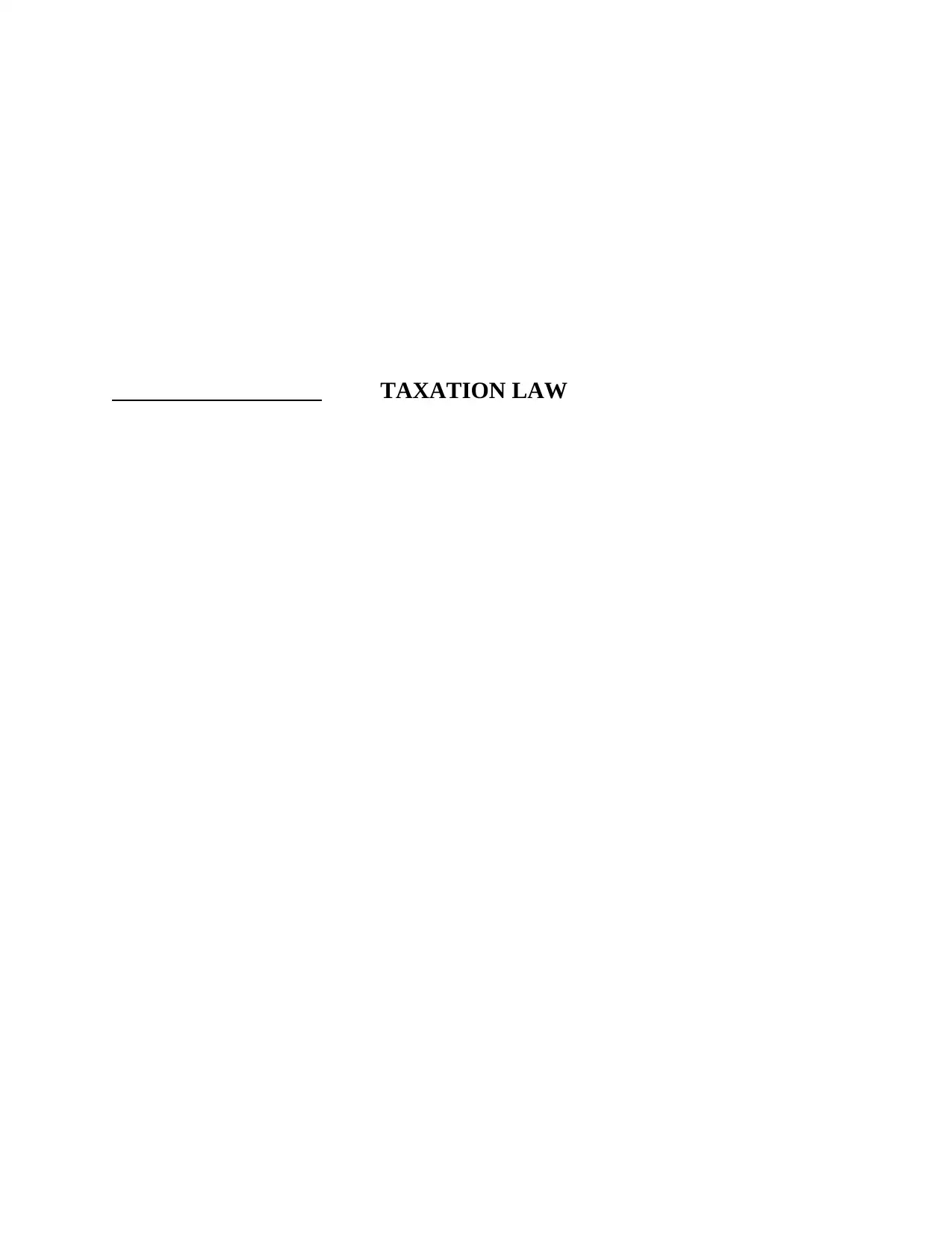
TAXATION LAW
Paraphrase This Document
Need a fresh take? Get an instant paraphrase of this document with our AI Paraphraser
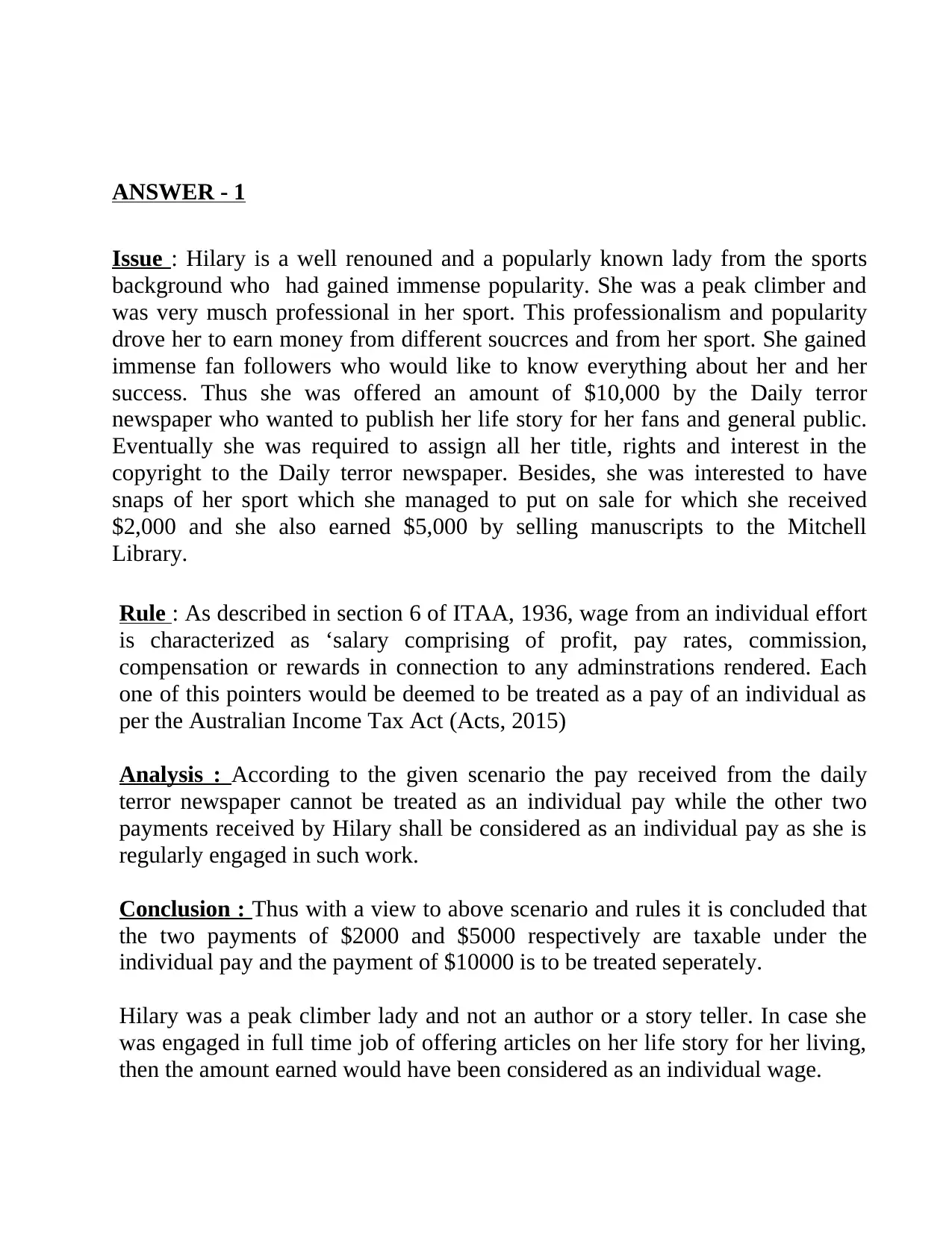
ANSWER - 1
Issue : Hilary is a well renouned and a popularly known lady from the sports
background who had gained immense popularity. She was a peak climber and
was very musch professional in her sport. This professionalism and popularity
drove her to earn money from different soucrces and from her sport. She gained
immense fan followers who would like to know everything about her and her
success. Thus she was offered an amount of $10,000 by the Daily terror
newspaper who wanted to publish her life story for her fans and general public.
Eventually she was required to assign all her title, rights and interest in the
copyright to the Daily terror newspaper. Besides, she was interested to have
snaps of her sport which she managed to put on sale for which she received
$2,000 and she also earned $5,000 by selling manuscripts to the Mitchell
Library.
Rule : As described in section 6 of ITAA, 1936, wage from an individual effort
is characterized as ‘salary comprising of profit, pay rates, commission,
compensation or rewards in connection to any adminstrations rendered. Each
one of this pointers would be deemed to be treated as a pay of an individual as
per the Australian Income Tax Act (Acts, 2015)
Analysis : According to the given scenario the pay received from the daily
terror newspaper cannot be treated as an individual pay while the other two
payments received by Hilary shall be considered as an individual pay as she is
regularly engaged in such work.
Conclusion : Thus with a view to above scenario and rules it is concluded that
the two payments of $2000 and $5000 respectively are taxable under the
individual pay and the payment of $10000 is to be treated seperately.
Hilary was a peak climber lady and not an author or a story teller. In case she
was engaged in full time job of offering articles on her life story for her living,
then the amount earned would have been considered as an individual wage.
Issue : Hilary is a well renouned and a popularly known lady from the sports
background who had gained immense popularity. She was a peak climber and
was very musch professional in her sport. This professionalism and popularity
drove her to earn money from different soucrces and from her sport. She gained
immense fan followers who would like to know everything about her and her
success. Thus she was offered an amount of $10,000 by the Daily terror
newspaper who wanted to publish her life story for her fans and general public.
Eventually she was required to assign all her title, rights and interest in the
copyright to the Daily terror newspaper. Besides, she was interested to have
snaps of her sport which she managed to put on sale for which she received
$2,000 and she also earned $5,000 by selling manuscripts to the Mitchell
Library.
Rule : As described in section 6 of ITAA, 1936, wage from an individual effort
is characterized as ‘salary comprising of profit, pay rates, commission,
compensation or rewards in connection to any adminstrations rendered. Each
one of this pointers would be deemed to be treated as a pay of an individual as
per the Australian Income Tax Act (Acts, 2015)
Analysis : According to the given scenario the pay received from the daily
terror newspaper cannot be treated as an individual pay while the other two
payments received by Hilary shall be considered as an individual pay as she is
regularly engaged in such work.
Conclusion : Thus with a view to above scenario and rules it is concluded that
the two payments of $2000 and $5000 respectively are taxable under the
individual pay and the payment of $10000 is to be treated seperately.
Hilary was a peak climber lady and not an author or a story teller. In case she
was engaged in full time job of offering articles on her life story for her living,
then the amount earned would have been considered as an individual wage.
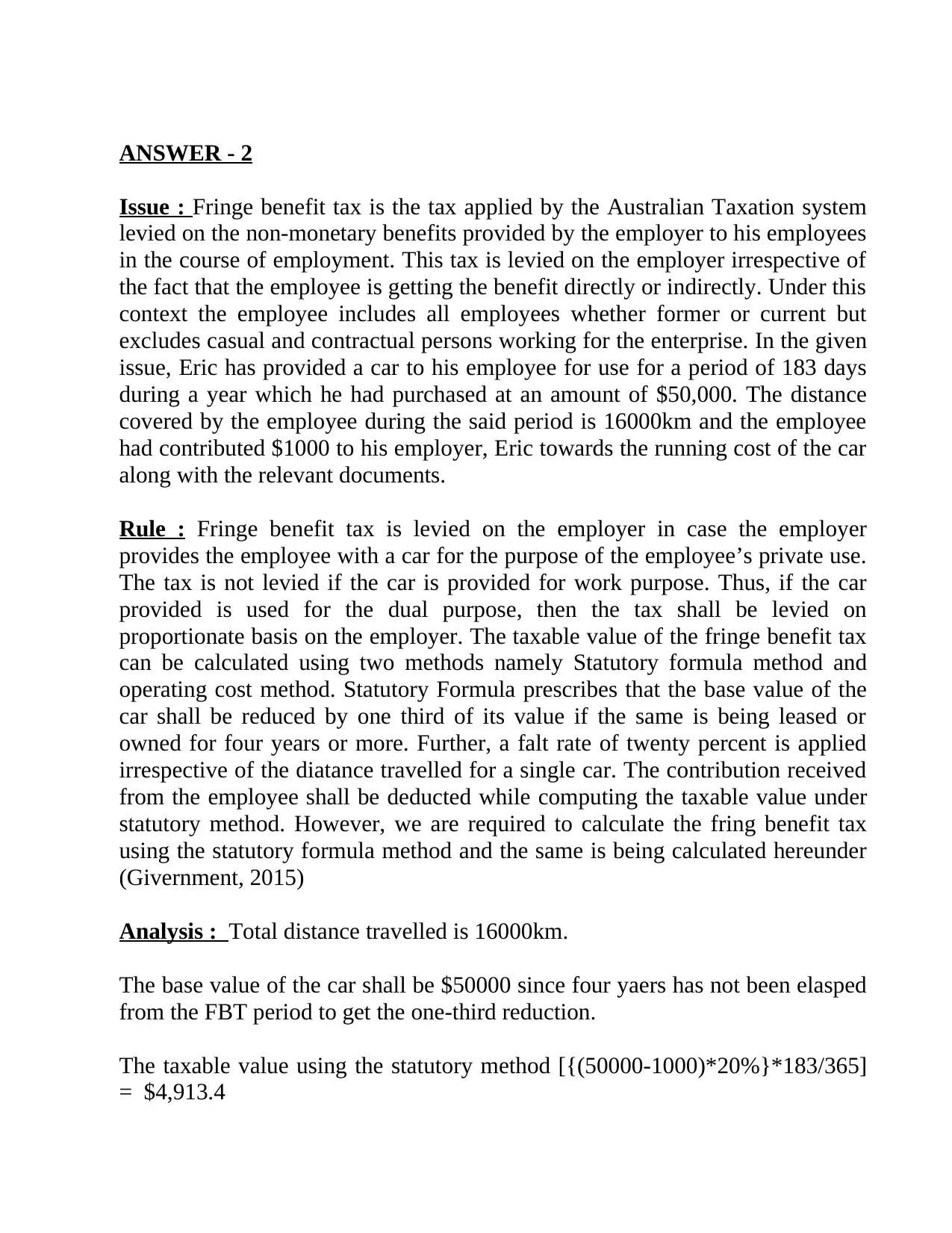
ANSWER - 2
Issue : Fringe benefit tax is the tax applied by the Australian Taxation system
levied on the non-monetary benefits provided by the employer to his employees
in the course of employment. This tax is levied on the employer irrespective of
the fact that the employee is getting the benefit directly or indirectly. Under this
context the employee includes all employees whether former or current but
excludes casual and contractual persons working for the enterprise. In the given
issue, Eric has provided a car to his employee for use for a period of 183 days
during a year which he had purchased at an amount of $50,000. The distance
covered by the employee during the said period is 16000km and the employee
had contributed $1000 to his employer, Eric towards the running cost of the car
along with the relevant documents.
Rule : Fringe benefit tax is levied on the employer in case the employer
provides the employee with a car for the purpose of the employee’s private use.
The tax is not levied if the car is provided for work purpose. Thus, if the car
provided is used for the dual purpose, then the tax shall be levied on
proportionate basis on the employer. The taxable value of the fringe benefit tax
can be calculated using two methods namely Statutory formula method and
operating cost method. Statutory Formula prescribes that the base value of the
car shall be reduced by one third of its value if the same is being leased or
owned for four years or more. Further, a falt rate of twenty percent is applied
irrespective of the diatance travelled for a single car. The contribution received
from the employee shall be deducted while computing the taxable value under
statutory method. However, we are required to calculate the fring benefit tax
using the statutory formula method and the same is being calculated hereunder
(Givernment, 2015)
Analysis : Total distance travelled is 16000km.
The base value of the car shall be $50000 since four yaers has not been elasped
from the FBT period to get the one-third reduction.
The taxable value using the statutory method [{(50000-1000)*20%}*183/365]
= $4,913.4
Issue : Fringe benefit tax is the tax applied by the Australian Taxation system
levied on the non-monetary benefits provided by the employer to his employees
in the course of employment. This tax is levied on the employer irrespective of
the fact that the employee is getting the benefit directly or indirectly. Under this
context the employee includes all employees whether former or current but
excludes casual and contractual persons working for the enterprise. In the given
issue, Eric has provided a car to his employee for use for a period of 183 days
during a year which he had purchased at an amount of $50,000. The distance
covered by the employee during the said period is 16000km and the employee
had contributed $1000 to his employer, Eric towards the running cost of the car
along with the relevant documents.
Rule : Fringe benefit tax is levied on the employer in case the employer
provides the employee with a car for the purpose of the employee’s private use.
The tax is not levied if the car is provided for work purpose. Thus, if the car
provided is used for the dual purpose, then the tax shall be levied on
proportionate basis on the employer. The taxable value of the fringe benefit tax
can be calculated using two methods namely Statutory formula method and
operating cost method. Statutory Formula prescribes that the base value of the
car shall be reduced by one third of its value if the same is being leased or
owned for four years or more. Further, a falt rate of twenty percent is applied
irrespective of the diatance travelled for a single car. The contribution received
from the employee shall be deducted while computing the taxable value under
statutory method. However, we are required to calculate the fring benefit tax
using the statutory formula method and the same is being calculated hereunder
(Givernment, 2015)
Analysis : Total distance travelled is 16000km.
The base value of the car shall be $50000 since four yaers has not been elasped
from the FBT period to get the one-third reduction.
The taxable value using the statutory method [{(50000-1000)*20%}*183/365]
= $4,913.4
⊘ This is a preview!⊘
Do you want full access?
Subscribe today to unlock all pages.

Trusted by 1+ million students worldwide
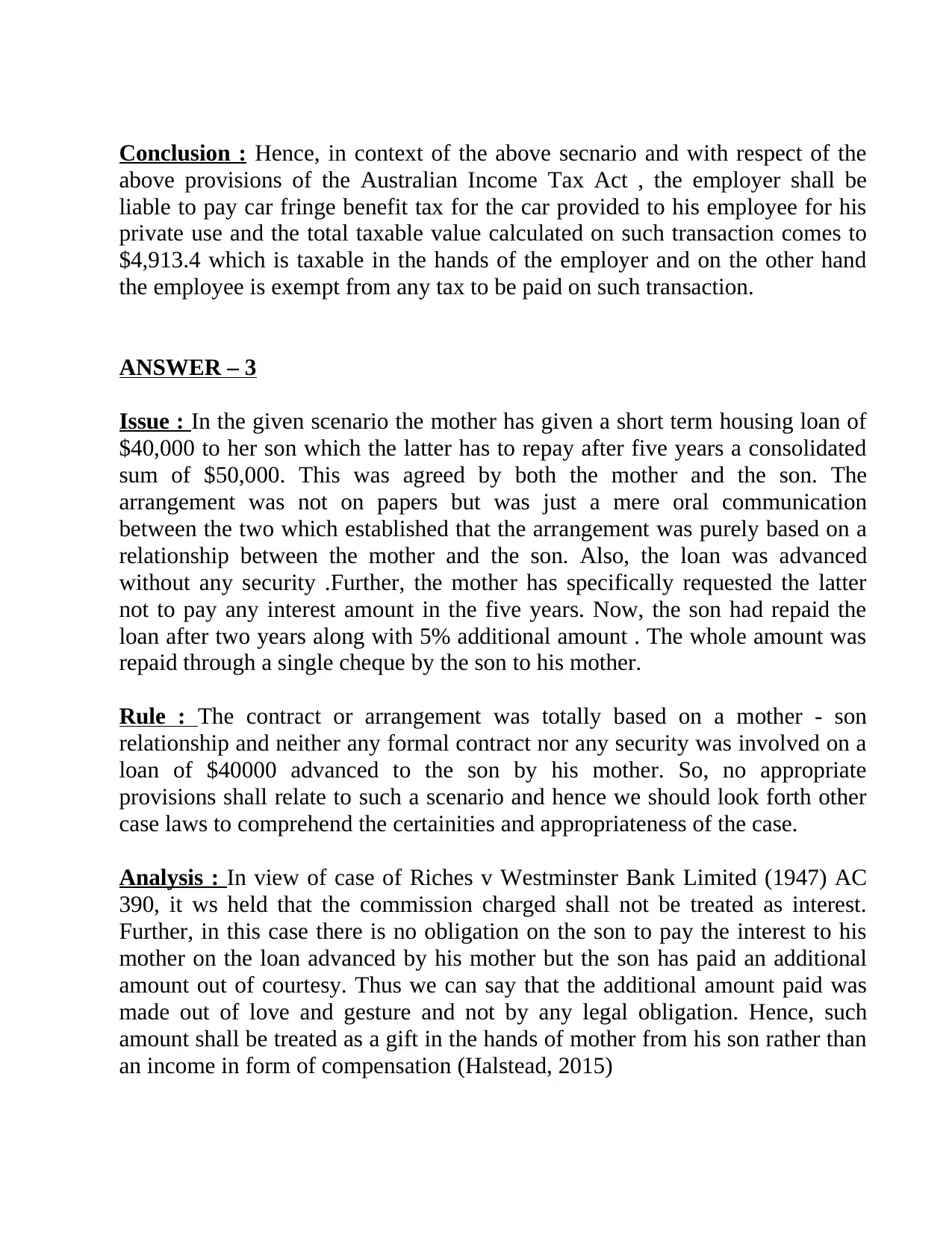
Conclusion : Hence, in context of the above secnario and with respect of the
above provisions of the Australian Income Tax Act , the employer shall be
liable to pay car fringe benefit tax for the car provided to his employee for his
private use and the total taxable value calculated on such transaction comes to
$4,913.4 which is taxable in the hands of the employer and on the other hand
the employee is exempt from any tax to be paid on such transaction.
ANSWER – 3
Issue : In the given scenario the mother has given a short term housing loan of
$40,000 to her son which the latter has to repay after five years a consolidated
sum of $50,000. This was agreed by both the mother and the son. The
arrangement was not on papers but was just a mere oral communication
between the two which established that the arrangement was purely based on a
relationship between the mother and the son. Also, the loan was advanced
without any security .Further, the mother has specifically requested the latter
not to pay any interest amount in the five years. Now, the son had repaid the
loan after two years along with 5% additional amount . The whole amount was
repaid through a single cheque by the son to his mother.
Rule : The contract or arrangement was totally based on a mother - son
relationship and neither any formal contract nor any security was involved on a
loan of $40000 advanced to the son by his mother. So, no appropriate
provisions shall relate to such a scenario and hence we should look forth other
case laws to comprehend the certainities and appropriateness of the case.
Analysis : In view of case of Riches v Westminster Bank Limited (1947) AC
390, it ws held that the commission charged shall not be treated as interest.
Further, in this case there is no obligation on the son to pay the interest to his
mother on the loan advanced by his mother but the son has paid an additional
amount out of courtesy. Thus we can say that the additional amount paid was
made out of love and gesture and not by any legal obligation. Hence, such
amount shall be treated as a gift in the hands of mother from his son rather than
an income in form of compensation (Halstead, 2015)
above provisions of the Australian Income Tax Act , the employer shall be
liable to pay car fringe benefit tax for the car provided to his employee for his
private use and the total taxable value calculated on such transaction comes to
$4,913.4 which is taxable in the hands of the employer and on the other hand
the employee is exempt from any tax to be paid on such transaction.
ANSWER – 3
Issue : In the given scenario the mother has given a short term housing loan of
$40,000 to her son which the latter has to repay after five years a consolidated
sum of $50,000. This was agreed by both the mother and the son. The
arrangement was not on papers but was just a mere oral communication
between the two which established that the arrangement was purely based on a
relationship between the mother and the son. Also, the loan was advanced
without any security .Further, the mother has specifically requested the latter
not to pay any interest amount in the five years. Now, the son had repaid the
loan after two years along with 5% additional amount . The whole amount was
repaid through a single cheque by the son to his mother.
Rule : The contract or arrangement was totally based on a mother - son
relationship and neither any formal contract nor any security was involved on a
loan of $40000 advanced to the son by his mother. So, no appropriate
provisions shall relate to such a scenario and hence we should look forth other
case laws to comprehend the certainities and appropriateness of the case.
Analysis : In view of case of Riches v Westminster Bank Limited (1947) AC
390, it ws held that the commission charged shall not be treated as interest.
Further, in this case there is no obligation on the son to pay the interest to his
mother on the loan advanced by his mother but the son has paid an additional
amount out of courtesy. Thus we can say that the additional amount paid was
made out of love and gesture and not by any legal obligation. Hence, such
amount shall be treated as a gift in the hands of mother from his son rather than
an income in form of compensation (Halstead, 2015)
Paraphrase This Document
Need a fresh take? Get an instant paraphrase of this document with our AI Paraphraser

Conclusion : With view to above case law and the issues involved in the
scenario it is concluded that the additional amount received by mother from his
son after two years is just out of love and courtesy and not through any legal
obligation. Hence, such amount is not taxable in the hands of mother and shall
be treated as gift from his son.
ANSWER – 4
In simple language Capital Gains’s is described as an excess of sale value of an
capital asset over its actual cost of acquisition. Similarly, Capital Loss is
defined as an excess of actual cost over its sale value. For the capital gain / loss
to be incurred it must be assured that the asset sold or transferred must be a
capital asset. The capital loss can be carried forward for a definite time period
and can also be allowed to set off against other capital gains as per the
provisions of the australian Income Tax Act. Where the asset transferred is a
long term asset , the cost of acquisition of such asset shall be subject to
indexation method. Further, if the owner of the asset is an individual, then it has
an option to opt refund methology or discount procedure. However, the same is
not available for persons other than individual. On the other hand any asset
purchased before 20.09.1985 wpold not be subject to capital gains as per the
Australian taxation rules.
Part A
The case is about an individual named Scott who is an accountant by profession
residing in Australia. He purchased a vacant land for the first time in Brisbane
on 01.10.1980. He further constructed a house on that land on 01.09.1986
costing $60000 when the fair value of land purchased on an earlier date was
$90000 and the same constructed flat was given on rent by Scott. However, it
was witnessed that Scott sold the said property at auction on 1st of March for a
total consideration of $8,00,000. Hence with a view to above provisions it is
clear from the facts that the transfer of property is liable to Capital Gains in the
hands of Scott. However, being an individual he has an option of opting either
the indexation method or the discounting procedure whichever is more
scenario it is concluded that the additional amount received by mother from his
son after two years is just out of love and courtesy and not through any legal
obligation. Hence, such amount is not taxable in the hands of mother and shall
be treated as gift from his son.
ANSWER – 4
In simple language Capital Gains’s is described as an excess of sale value of an
capital asset over its actual cost of acquisition. Similarly, Capital Loss is
defined as an excess of actual cost over its sale value. For the capital gain / loss
to be incurred it must be assured that the asset sold or transferred must be a
capital asset. The capital loss can be carried forward for a definite time period
and can also be allowed to set off against other capital gains as per the
provisions of the australian Income Tax Act. Where the asset transferred is a
long term asset , the cost of acquisition of such asset shall be subject to
indexation method. Further, if the owner of the asset is an individual, then it has
an option to opt refund methology or discount procedure. However, the same is
not available for persons other than individual. On the other hand any asset
purchased before 20.09.1985 wpold not be subject to capital gains as per the
Australian taxation rules.
Part A
The case is about an individual named Scott who is an accountant by profession
residing in Australia. He purchased a vacant land for the first time in Brisbane
on 01.10.1980. He further constructed a house on that land on 01.09.1986
costing $60000 when the fair value of land purchased on an earlier date was
$90000 and the same constructed flat was given on rent by Scott. However, it
was witnessed that Scott sold the said property at auction on 1st of March for a
total consideration of $8,00,000. Hence with a view to above provisions it is
clear from the facts that the transfer of property is liable to Capital Gains in the
hands of Scott. However, being an individual he has an option of opting either
the indexation method or the discounting procedure whichever is more
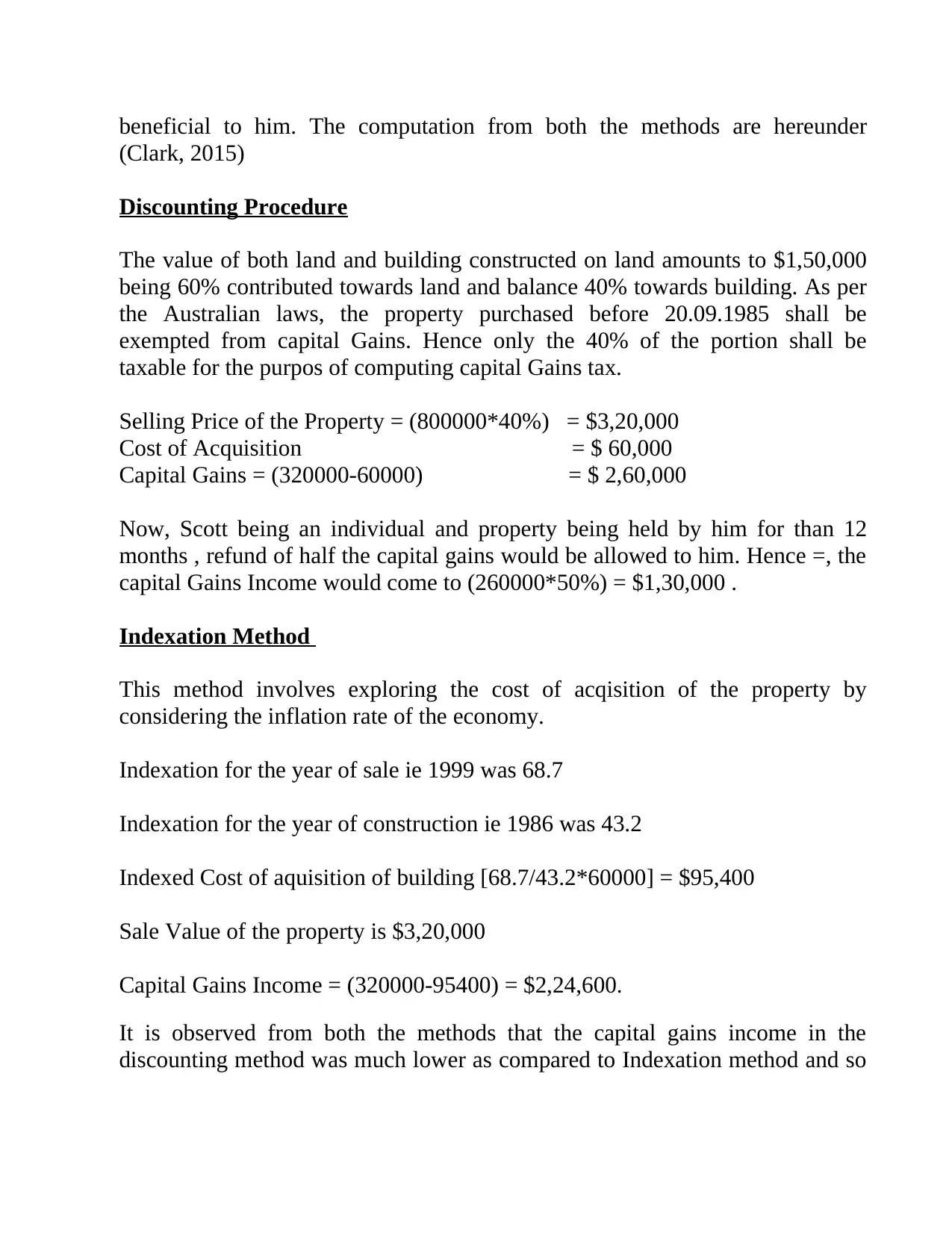
beneficial to him. The computation from both the methods are hereunder
(Clark, 2015)
Discounting Procedure
The value of both land and building constructed on land amounts to $1,50,000
being 60% contributed towards land and balance 40% towards building. As per
the Australian laws, the property purchased before 20.09.1985 shall be
exempted from capital Gains. Hence only the 40% of the portion shall be
taxable for the purpos of computing capital Gains tax.
Selling Price of the Property = (800000*40%) = $3,20,000
Cost of Acquisition = $ 60,000
Capital Gains = (320000-60000) = $ 2,60,000
Now, Scott being an individual and property being held by him for than 12
months , refund of half the capital gains would be allowed to him. Hence =, the
capital Gains Income would come to (260000*50%) = $1,30,000 .
Indexation Method
This method involves exploring the cost of acqisition of the property by
considering the inflation rate of the economy.
Indexation for the year of sale ie 1999 was 68.7
Indexation for the year of construction ie 1986 was 43.2
Indexed Cost of aquisition of building [68.7/43.2*60000] = $95,400
Sale Value of the property is $3,20,000
Capital Gains Income = (320000-95400) = $2,24,600.
It is observed from both the methods that the capital gains income in the
discounting method was much lower as compared to Indexation method and so
(Clark, 2015)
Discounting Procedure
The value of both land and building constructed on land amounts to $1,50,000
being 60% contributed towards land and balance 40% towards building. As per
the Australian laws, the property purchased before 20.09.1985 shall be
exempted from capital Gains. Hence only the 40% of the portion shall be
taxable for the purpos of computing capital Gains tax.
Selling Price of the Property = (800000*40%) = $3,20,000
Cost of Acquisition = $ 60,000
Capital Gains = (320000-60000) = $ 2,60,000
Now, Scott being an individual and property being held by him for than 12
months , refund of half the capital gains would be allowed to him. Hence =, the
capital Gains Income would come to (260000*50%) = $1,30,000 .
Indexation Method
This method involves exploring the cost of acqisition of the property by
considering the inflation rate of the economy.
Indexation for the year of sale ie 1999 was 68.7
Indexation for the year of construction ie 1986 was 43.2
Indexed Cost of aquisition of building [68.7/43.2*60000] = $95,400
Sale Value of the property is $3,20,000
Capital Gains Income = (320000-95400) = $2,24,600.
It is observed from both the methods that the capital gains income in the
discounting method was much lower as compared to Indexation method and so
⊘ This is a preview!⊘
Do you want full access?
Subscribe today to unlock all pages.

Trusted by 1+ million students worldwide

Scott shall choose the discounting method that would ethically reduce its tax
liabilty.
PART – B
In the given scenario the property is being sold to his daughter for a
consideration of $2,00,000. As per the provisons of the Australian Tax Laws
the sale value of the capital asset on being transferred shall be higher of the
market value of the property as estimated by the Government or the actual sale
value. Hence, in the given circumstance, the sale value of the property shall be
considered as $8,00,000 and not the actual sale value ie $2,00,000.
Accordingly, being the sale value same as that in Part A, the Capital Gains
income of Scott shall be same as Part A ie- $1,30,000 (conversation, 2015)
PART – C
In the given situation the owner of the property is a Company and not an
individual. In such a case, the provisions of Discounting method shall not be
applicable to the company and the company shall follow the Indexation method
compulsarily.
Thus, the indexation method would result in the Capital Gains Income of
$2,24,600 in the hands of the company as caluculated in Part A of the question
(Burman, 2015)
Bibliography
Acts, C. C. (2015). INCOME TAX ASSESSMENT ACT 1936. Retrieved from http://www8.austlii.edu.au/cgi-
bin/viewdb/au/legis/cth/consol_act/itaa1936240/
Burman, L. (2015). Taxing Capital Gains in Australia:. Retrieved from
http://www.taxpolicycenter.org/sites/default/files/alfresco/publication-pdfs/411857-Taxing-
Capital-Gains-in-Australia-Assessment-and-Recommendations.PDF
Clark, A. (2015). Capital gains tax:. Retrieved from
https://static.treasury.gov.au/uploads/sites/1/2017/06/03Clark.pdf
conversation, T. (2015). Articles on Capital gains tax. Retrieved from
http://theconversation.com/au/topics/capital-gains-tax-2813
Givernment, A. (2015). Car fringe benefits. Retrieved from https://www.ato.gov.au/General/Fringe-
benefits-tax-(FBT)/Types-of-fringe-benefits/Car-fringe-benefits/
liabilty.
PART – B
In the given scenario the property is being sold to his daughter for a
consideration of $2,00,000. As per the provisons of the Australian Tax Laws
the sale value of the capital asset on being transferred shall be higher of the
market value of the property as estimated by the Government or the actual sale
value. Hence, in the given circumstance, the sale value of the property shall be
considered as $8,00,000 and not the actual sale value ie $2,00,000.
Accordingly, being the sale value same as that in Part A, the Capital Gains
income of Scott shall be same as Part A ie- $1,30,000 (conversation, 2015)
PART – C
In the given situation the owner of the property is a Company and not an
individual. In such a case, the provisions of Discounting method shall not be
applicable to the company and the company shall follow the Indexation method
compulsarily.
Thus, the indexation method would result in the Capital Gains Income of
$2,24,600 in the hands of the company as caluculated in Part A of the question
(Burman, 2015)
Bibliography
Acts, C. C. (2015). INCOME TAX ASSESSMENT ACT 1936. Retrieved from http://www8.austlii.edu.au/cgi-
bin/viewdb/au/legis/cth/consol_act/itaa1936240/
Burman, L. (2015). Taxing Capital Gains in Australia:. Retrieved from
http://www.taxpolicycenter.org/sites/default/files/alfresco/publication-pdfs/411857-Taxing-
Capital-Gains-in-Australia-Assessment-and-Recommendations.PDF
Clark, A. (2015). Capital gains tax:. Retrieved from
https://static.treasury.gov.au/uploads/sites/1/2017/06/03Clark.pdf
conversation, T. (2015). Articles on Capital gains tax. Retrieved from
http://theconversation.com/au/topics/capital-gains-tax-2813
Givernment, A. (2015). Car fringe benefits. Retrieved from https://www.ato.gov.au/General/Fringe-
benefits-tax-(FBT)/Types-of-fringe-benefits/Car-fringe-benefits/
Paraphrase This Document
Need a fresh take? Get an instant paraphrase of this document with our AI Paraphraser
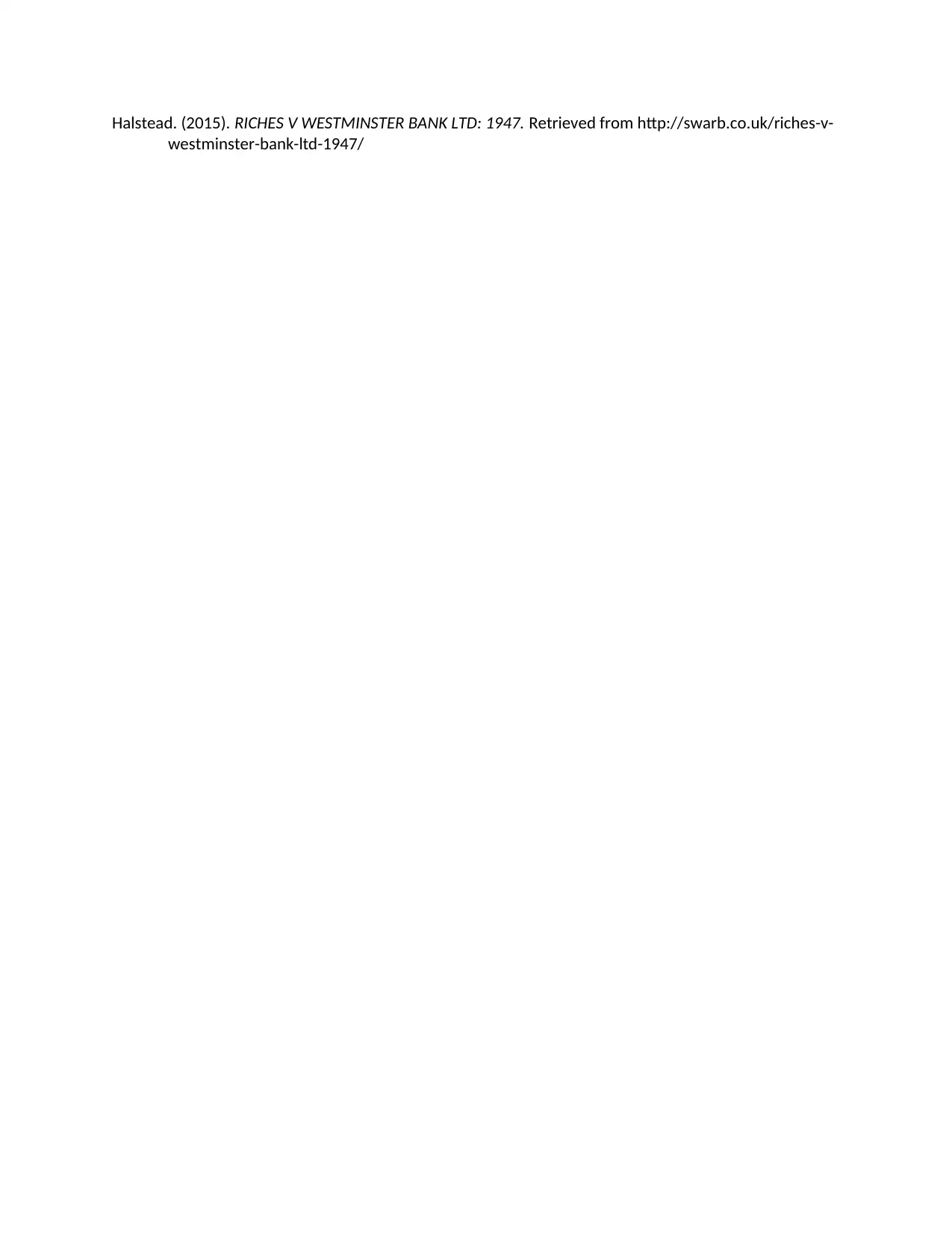
Halstead. (2015). RICHES V WESTMINSTER BANK LTD: 1947. Retrieved from http://swarb.co.uk/riches-v-
westminster-bank-ltd-1947/
westminster-bank-ltd-1947/
1 out of 8
Related Documents
Your All-in-One AI-Powered Toolkit for Academic Success.
+13062052269
info@desklib.com
Available 24*7 on WhatsApp / Email
![[object Object]](/_next/static/media/star-bottom.7253800d.svg)
Unlock your academic potential
Copyright © 2020–2025 A2Z Services. All Rights Reserved. Developed and managed by ZUCOL.





